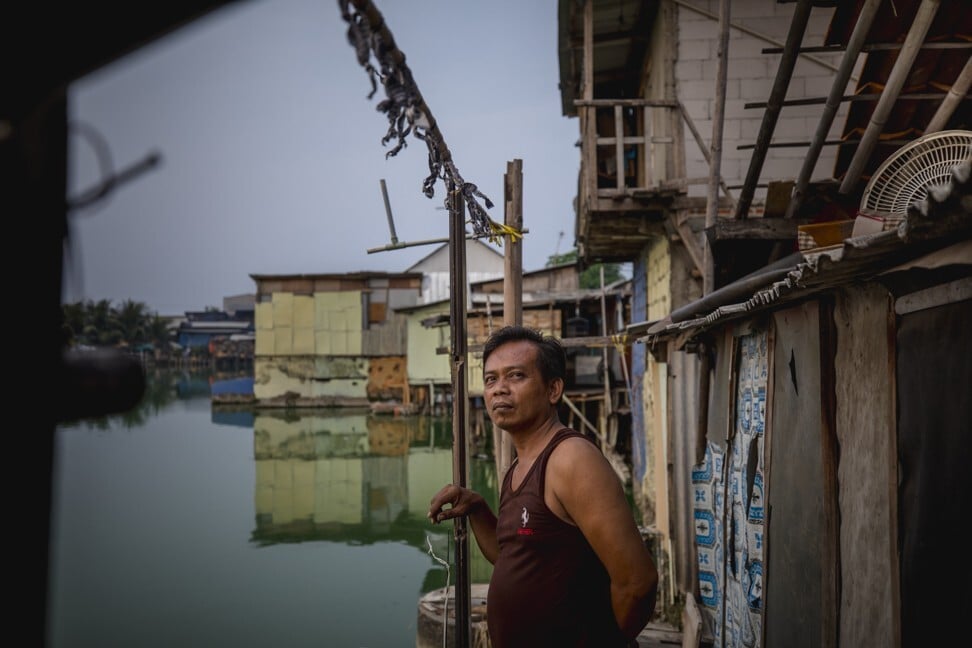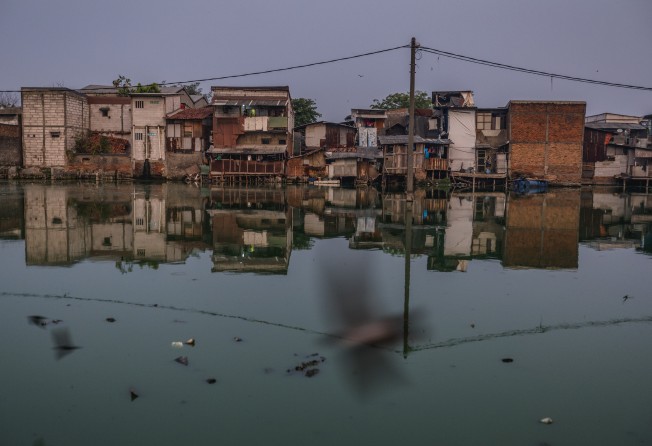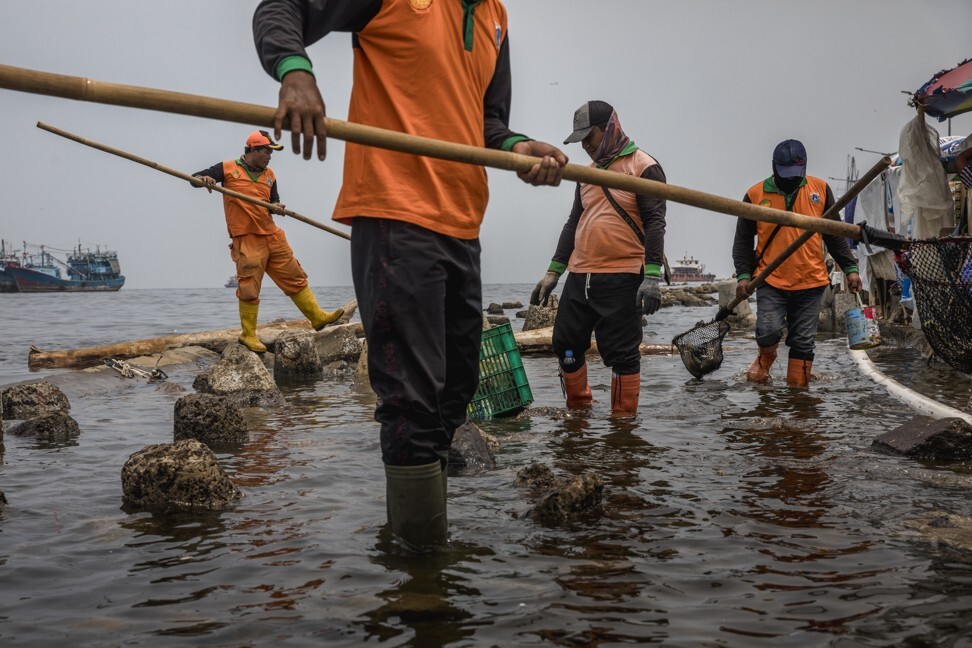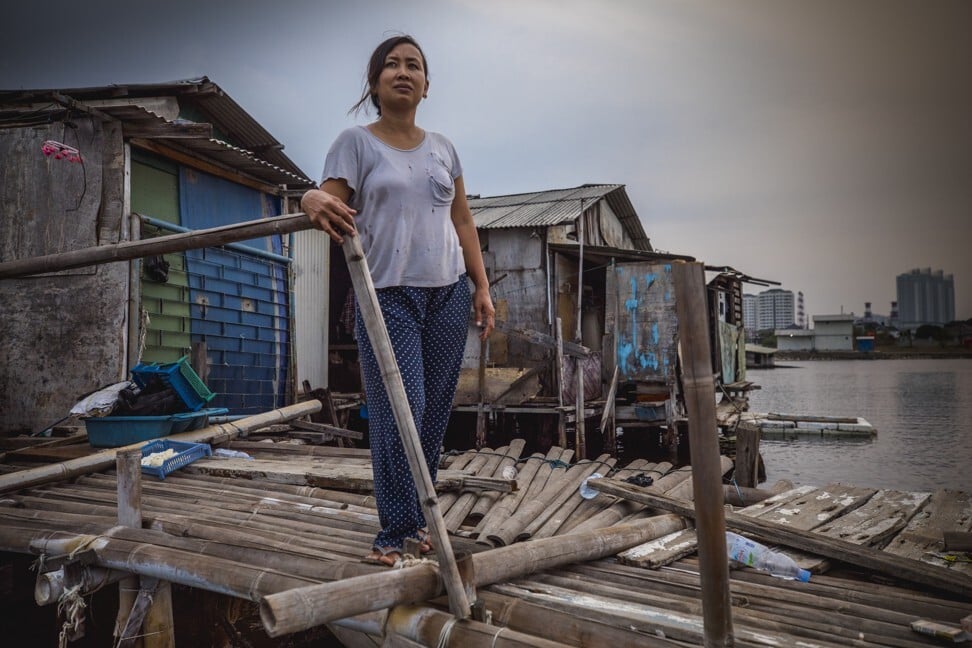
As Jakarta sinks and the Indonesian government prepares to move, what does the future hold for the city’s poor?
Efforts to shore up defences include building sea walls and wells, clearing the waterways and greening urban areas. Yet its northern slums continue to be inundated

Yayan Suprianto surveys the floodwater surrounding his house of wooden planks and a corroded tin roof in Kampung Teko, “kampung” being a catchword for urban slums. He is part of a community of 300 people in what is considered the only “floating village” in Jakarta, the world’s second-most populous urban area after Tokyo.
Perched above what used to be lush paddy fields, Yayan’s shack spills over support poles driven deep into the mud. It is surrounded by algae and discarded plastic and the water is contaminated by industrial waste from nearby factories.
Yayan is a factory worker from western Java who, like millions of Indonesians, came to the capital in search of employment and a better life. But now he worries his house could soon become fully submerged. “We probably have to move back to our village,” he says.
The government has invested in pumps, but “the water rises every year”, Yayan says. “Before, we used to have floods only during the rainy season, but now they come more frequently.”

Jakarta is sinking. Forty per cent of the city now lies below sea level and it is sinking at different rates in different places, from 1cm a year up to 25cm in the worst affected northern areas, near the coast. The problem is so severe that it is one of the reasons that Indonesian President Joko Widodo announced the capital would be relocated to a new site in East Kalimantan, on Borneo, last August, with construction possibly due to begin this year. Even so, many people believe Jakarta will remain Indonesia’s business and financial hub.
Jakarta is not the only coastal city in trouble. Also facing rising sea levels, more frequent rains and stronger storms are the likes of Bangkok, Dhaka, Houston, Lagos and Venice. But Jakarta is sinking fastest.
The city’s plight is not just a consequence of climate change, however. It is also due to a lack of clean water.
According to the central government’s statistics agency, about 60 per cent of Jakarta’s residents lack access to clean water. Less than half have access to any water pipes at all. So many people extract water through illegal pumps that the natural aquifers are being emptied, leading to consolidation of the formerly porous soil beneath the city.
Magnifying the problem, the marshland and mangroves that once absorbed excess water have been largely replaced by shopping malls and high-rises. Torrential rain pours off the asphalt and concrete, flooding the city and putting ever more pressure on its 13 rivers. Over the past two decades, parts of Jakarta – mainly in the north – have submerged by up to four metres, making it nearly impossible to drain the water from places such as Kampung Teko.
Climate expert Dicky Edwin Hindarto, coordinator at the Jakarta-based Indonesia Low Emission Network, says, “Jakarta has no green spaces left. We need to increase areas of parkland and mangroves instead of surfaces covered in concrete.”
The city actually sinks under the weight of the concrete buildings constantly under construction. The government needs to act now
In this, Hindarto is supported by Elisa Sutanudjaja at the Jakarta-based think tank Rujak Centre for Urban Studies.
“We must stop existing [construction] permits and instead create many new green spaces,” she says.
Sutanudjaja works with a number of organisations to implement sustainable urban solutions and has been the force behind moves to halt construction permits for the 17 artificial islands of the Great Garuda project, which also includes a 40km-long sea wall across Jakarta Bay. This project has been reduced in scale and the plan to build the islands – other than one that has already been constructed – has been abandoned.
Sutanudjaja explains Jakarta’s problems while strolling under new trees planted around Citra Lake, one of hundreds of freshwater reservoirs in the capital that will need to be saved to avert catastrophe.
“The city actually sinks under the weight of the concrete buildings constantly under construction,” she says. “The government needs to act now.”

Dudi Gardesi is head of the municipal government’s division for water resources, which oversees river clean-ups. One of the main goals for the past couple of years has been to restore free-flowing waterways to lower the risk of flooding and act as sources of fresh water, as well as creating new ones. The initiative is finally showing results.
“We have set aside a higher budget for education. I think we can reach the goals to have clean water in Jakarta by 2030,” Dudi says.
Close to Dudi’s workplace, the stench of rubbish hovers over the gently flowing Banjir Kanal Barat, or West Flood Canal. On the banks, dogs and goats sift the refuse for food. Jakarta’s “orange army”, employees of the city’s environmental department, are working to rid the river of plastics, tyres, drinks cans and full garbage bags.
Work began on clearing the city’s waterways in 2016. One of the orange-clad workers, Sumarto, who joined the clean-up three years ago, sees progress.
“Before we started cleaning up the river, there was so much waste that we could play soccer on it,” he says.

While far from pristine, seagrass has returned to the canal bed and insects as well as fish can be seen at the surface.
“The wildlife is coming back,” Sumarto says. “The next step is to replant bushes and trees along the rivers.” The vegetation will attract insects and birds, he says, “and the trees will also absorb water and limit flooding along the river”.
Jakarta’s provincial government plans call for more greenery draped on central high-rise commercial buildings, inspired by Singapore’s city planning. Fewer construction permits have been granted and new buildings must comply with the latest regulations on energy use, waste and water efficiency. At the same time, more mangroves are being replanted in the city’s outskirts.
“The replanting of mangroves and parks in Greater Jakarta is under way,” says Hindarto. “But it needs to occur at a faster rate.”
A 2012 report by the World Bank warned that serious floods would become more common in Jakarta “resulting in severe socio-economic damage”. For the past two decades, researchers at the Bandung Institute of Technology, in West Java, have been researching Jakarta’s land subsidence using satellite radar technology. In that time, parts of the city have sunk by four metres. Business as usual would see parts of the city inundated by the Java Sea and the evacuation of millions, including Yayan in Kampung Teko.
The younger generation have a different mindset. We want to recycle, remove plastics and have a smaller CO2-footprint
Among the measures being taken by the city is a project designed to make wells part of the solution, rather than their being part of the problem. The city’s 4,500 registered wells – and unknown number of illegal wells – draining water from the aquifers is one of the main causes of the subsidence.
The provincial government’s head of geology and groundwater, Togas Braini, says the idea is to set up shallow “infiltration wells” that allow water to seep into the ground, helping to drain excess rain and floodwater and refill the aquifers. “In 2019, we built 1,300,” he says.
This idea is gaining traction outside government. SMA Negeri 27 Jakarta – one of the city’s 100 or so “green schools”, where environmental science and sustainability are part of the curriculum – has 13 infiltration wells on the premises, controlling rainwater inundation. The school also prohibits single-use plastics and requires pupils to bring their own reusable water bottles.
One student, 16-year-old Diah Oktavia, is eager to be part of the transformation.
“The younger generation have a different mindset,” she says. “We want to recycle, remove plastics and have a smaller CO2-footprint than the older generation.”

At Muara Angke, another kampung neighbourhood in northern Jakarta, the orange army is collecting plastic trash in hoop nets strung from a four-metre-high concrete sea wall erected along the wharf. This wall, which will eventually be 20km long, is the first concrete protection against the invading Java Sea in this part of Jakarta, which is sinking by about 20cma year.
On the wrong side of the wall, Waladuna mosque has become a symbol of the sinking city. Built in the 1980s, it is submerged in a metre of seawater at low tide; at high tide, the water creeps up to the moss-covered roof. Nearby, abandoned warehouses and fish factories are reminders of a more prosperous past.
Five kilometres east, in Kampung Gedung Pompa, Ita Amaliah, 34, cooks food for passing customers. The street-food stall supports Ita, her husband and their two children, who live in a shack next to the wall. They have no access to a water pipe or well and must purchase water in containers. Even so, the sea wall feels secure, she says. At least, for now.
The government aims to relocate the family and their neighbours to new high-rises, but Ita fears they won’t be able to afford the rent. So far they haven’t been informed of when and where they will be relocated, and their life is in limbo.

When Widodo announced the capital would be relocated to Borneo, along with 1.5 million of Jakarta’s inhabitants, he raised more questions than answers. The president maintains that he wants to level out some of Indonesia’s social and industrial inequalities by relocating the capital from Java – which boasts 60 per cent of the country’s population and 58 per cent of its GDP – to Kalimantan, which is four times bigger but accounts for a mere 8 per cent of GDP.
It would also take some pressure off Jakarta, where the population continues to grow by 250,000 a year even as the waters rise. The move is to begin in 2024, with soft groundbreaking from July and infrastructure projects commencing next year.
Environmentalists are concerned the move will be devastating to Borneo’s remaining rainforests and endangered wildlife. The government, however, says the existing protected forests will be left intact and the new capital will be a “city forest”, with 10 per cent of its land dedicated to green areas. Meanwhile, opponents describe the US$33 billion project as a political stunt, which will only benefit government officials who want to escape the congested and sinking capital.
Ita has heard of the relocation plans, but no one in her kampung seems to know what they would entail. As a group of naked young boys leap into the sea from a wooden jetty next to the wall, she wonders whether the government’s plans are to clean up the slums to facilitate the construction of expensive apartments. Like Yayan and so many of the city’s poor, she faces an uncertain future.
Ita stares over the ledge of the sea wall.
“We just want to make a living here,” she says. “But I don’t think that will be the case with the sea level increasing. Where else could we go?”